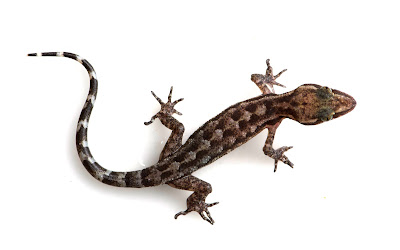Abstract
We describe six new species of Cyrtodactylus from the khasiensis group using morphological characteristics, supported by the molecular analyses based on the mitochondrial ND2 gene. We used four different molecular species delimitation analyses that recovered six distinct undescribed lineages distributed across four states in northeastern India. Our phylogenetic analyses using ML and Bayesian approaches recovered a clade where the recently described C. arunachalensis and C. cayuensis align together with our other samples from Arunachal Pradesh, north of Brahmaputra River. Based on these results and overlapping morphological characteristics we synonymize C. arunachalensis with C. cayuensis. We provide updated comparative morphological characters for species in the khasiensis group and where available these characters are tabulated for males and females separately. Including the six new species the khasiensis group now contains 35 species, of which 26 are endemic to India.
Keywords: Himalaya, Indo-Burma Biodiversity Hotspot, molecular phylogeny, Sauria, taxonomy
gansi clade
Cyrtodactylus kiphire Boruah, Narayanan, Deepak & Das, sp. nov.
Diagnosis: A medium-sized gecko (SVL up to at least 64.7 mm); 10 supralabials; 9–12 infralabials; 16 bluntly conical and feebly keeled dorsal tubercles; 26–29 paravertebral tubercles; 35 or 36 midventral scales rows between the weak ventrolateral folds; no precloacal groove; six or seven precloacal pores in continuous series; 12–15 total subdigital lamellae beneath digit IV of pes; dark brown irregular cross bars or reticulation on dorsum.
Etymology: The specific epithet is derived from Kiphire, a District of Nagaland from where the type series of this species were collected.
Suggested common name: Kiphire bent-toed gecko.

Cyrtodactylus barailensis Boruah, Narayanan, Deepak & Das, sp. nov.
Diagnosis: Medium-sized gecko, SVL at least 68.8 mm in adult female; supralabials 9–12 and infralabials nine; 12 or 13 lamellae beneath the digit IV of manus; 17 lamellae beneath digit IV of pes; 17 feebly keeled and bluntly conical tubercles across mid dorsum and 32 paravertebral tubercles; 36 smooth mid-ventral scales between ventrolateral folds; at least 10 small precloacal pores in female; head on top pale-brown with purplish tinge; dark-brown postorbital stripe continuing to above the ear opening; a dark-brown cross bar with irregular edges on nape; indistinct pale-yellow patch on occipital region; dorsally and laterally neck and back pale yellowish-brown with dark-brown irregular reticulation.
Etymology: The specific epithet is a toponym derived from the name of the hill range “Barail” where the type locality of the species lies.
Suggested common name: Barail Hills bent-toed gecko.
Cyrtodactylus manipurensis Boruah, Narayanan, Deepak & Das, sp. nov.
Diagnosis: Medium-sized gecko, SVL at least 59.5 mm in adult male; 10 supralabials; eight or nine infralabials; 21 bluntly conical and feebly keeled tubercles across midbody; 37 paravertebral tubercles; 36 mid-ventral scales between ventrolateral folds; 11 or 12 subdigital lamellae beneath digit IV of manus; 13–16 subdigital lamellae beneath digit IV of pes; seven precloacal pores arranged in a continuous series; six irregular shaped dark-brown cross bands on back between axilla and groin; tail dorsally with eight dark-brown and seven pale-brown bands arranged alternatively.
Etymology: This species is named after Manipur state in India.
Suggested common name: Manipur bent-toed gecko.
khasiensis clade
Cyrtodactylus ngengpuiensis Boruah, Narayanan, Lalronunga, Deepak & Das, sp. nov.
Diagnosis: Medium-sized gecko (SVL at least 61.2 mm in adult male and 72–74.1 mm in adult females); 9–12 supralabials; 8–11 infralabials; 18–20 bluntly conical and feebly keeled dorsal tubercles; 29–34 paravertebral tubercles; 38 or 39 midventral scale rows between the weak ventrolateral folds; no precloacal groove; at least 27 precloacofemoral pores in continuous series in male and 10–16 small precloacal pores in females; short dark-brown bars between a pair of dorsolateral stripes or enlarged irregular dark-brown spots present on dorsum.
Etymology: The specific epithet is a toponym derived from the name “Ngengpui Wildlife Sanctuary” of Mizoram state from where the type series of the species were collected.
Suggested common name: Ngengpui bent-toed gecko.
mombergi clade
Cyrtodactylus namdaphaensis Boruah, Narayanan, Deepak & Das, sp. nov.
Diagnosis: Medium-sized gecko (SVL 57.5–70.7 mm in males and SVL 54.8–69.3 mm in females); supralabials and infralabials 8–11; dorsum with weakly keeled and bluntly conical tubercles, 29–36 paravertebral tubercles between the level of axilla and level of groin; 17–19 dorsal tubercle rows at mid body; 33–40 mid ventral scale rows; seven to nine precloacal pores in males and 8–10 small precloacal pores in females in a continuous series, PcP much smaller in females than that of males; 12–14 subdigital lamellae on finger IV and 11–17 subdigital lamellae on toe IV; irregular dark-brown spots or stripes on dorsum.
Etymology: The specific epithet is a toponym named after its type locality Namdapha Tiger Reserve in Arunachal Pradesh, India.
Suggested common name: Namdapha bent-toed gecko.
cayuensis clade
 |
| Cyrtodactylus siangensis sp. nov. an uncollected male in natural habitat from Jorsing, East Siang, Arunachal Pradesh. |
Cyrtodactylus siangensis Boruah, Narayanan, Aravind, Deepak & Das, sp. nov.
Diagnosis: Medium-sized gecko (SVL 70.1–72.1 mm in females); males unknown; supralabials 8–12 and infralabials 9–12; tubercles on dorsum weakly keeled and bluntly conical, 26–32 paravertebral tubercles between the level of axilla and level of groin; 15 or 16 dorsal tubercle rows at mid body; 40–45 mid ventral scale rows; 8–10 small precloacal pores in a continuous series; 13–17 subdigital lamellae on finger IV and 14–19 subdigital lamellae on toe IV; six or seven irregular and broken dark-brown bands on dorsum between the level of axilla and level of groin, or irregular dark-brown reticulation on dorsum.
Bitupan Boruah, Surya Narayanan, Neelavar Ananthram Aravind, Samuel Lalronunga, V. Deepak and Abhijit Das. 2024. Description of Six New Species of Cyrtodactylus Gray (Squamata: Gekkonidae) from northeastern India. Vertebrate Zoology. 74: 453-486. DOI: doi.org/10.3897/vz.74.e124752






